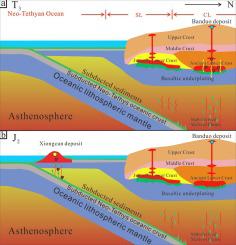当前位置:
X-MOL 学术
›
Ore Geol. Rev.
›
论文详情
Our official English website, www.x-mol.net, welcomes your feedback! (Note: you will need to create a separate account there.)
Discovery of Late Triassic mineralization in the Gangdese Metallogenic Belt, Tibet: The Banduo Pb–Zn deposit, Somdo area
Ore Geology Reviews ( IF 3.3 ) Pub Date : 2020-11-01 , DOI: 10.1016/j.oregeorev.2020.103754 Lin-han Li , Chao-ming Xie , Yun-sheng Ren , Yun-peng Yu , Yu-chao Dong , Zhong-wei Gao , Yu-jie Hao
Ore Geology Reviews ( IF 3.3 ) Pub Date : 2020-11-01 , DOI: 10.1016/j.oregeorev.2020.103754 Lin-han Li , Chao-ming Xie , Yun-sheng Ren , Yun-peng Yu , Yu-chao Dong , Zhong-wei Gao , Yu-jie Hao

|
Abstract The newly discovered Banduo Pb–Zn deposit in the Somdo area of Tibet is hosted by a Late Triassic granodiorite. A combination of zircon U–Pb dating, Hf isotopic compositions, sulfide Rb–Sr dating, and whole-rock geochemistry was used to determine the age of the mineralization and characterize the metallogenesis of the deposit. The weighted-mean U–Pb ages of zircon from the granodiorite (203.8 ± 1.7 Ma, MSWD = 0.53; 206.1 ± 0.4 Ma, MSWD = 0.098) and the weighted-mean Rb–Sr isochron age of sulfides from the Pb–Zn mineralization (202.7 ± 2.3 Ma; MSWD = 1.3) suggest that the timing of mineralization was close to that of granodiorite crystallization during the Late Triassic. The average (87Sr/86Sr)i value of 0.71026 implies that the ore-forming metals were sourced from a mixture of mantle and crustal material. The weakly altered granodiorite of the deposit is characterized by SiO2 = 66.78–67.85 wt%, K2O = 2.57–3.37 wt%, Al2O3 = 13.53–15.15 wt%, and Mg# = 45.5–51.3. It is enriched in LREEs and LILEs and depleted in HREEs and HFSEs, and it exhibits a negative Eu anomaly. The granodiorite has positive and negative eHf(t) values (−2.5 to 1.7) and crustal model ages (TC DM) of 1.14–1.40 Ga. Hf isotopic analyses and whole-rock geochemistry indicate that the Late Triassic granodiorite was likely sourced from of a mixture of mantle and ancient lower-crust material that had undergone variable degrees of fractional crystallization. Based on regional data, the Banduo deposit is the oldest Pb–Zn deposit in the Gangdese belt and likely formed as a result of the northward subduction of the Neo-Tethys Ocean. The metallogenic epoch indicates that deposits related to the northward subduction of the Neo-Tethys oceanic crust exist in this area. The Late Triassic age of granitoid-hosted mineralization provides additional prospects for exploration in the Gangdese Metallogenic Belt.
更新日期:2020-11-01



























 京公网安备 11010802027423号
京公网安备 11010802027423号